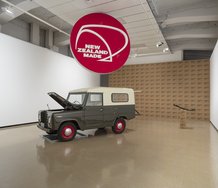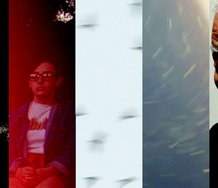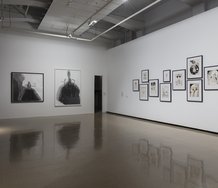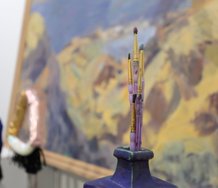Mark Amery – 3 March, 2011
The three works on found board are, with the laces, the stars of the show. Here a hieroglyphic language is incised out of the existing paint layers as if allowing the past to speak. They are delicate and expressive in colour and in the selection of different small actions.
This is a rather smart show. One that visibly gives an impression of how important rigorous process is for an artist.
From the spread of work, it’s clear Patrick Lundberg carefully picks found materials and paint, working through shift-by-shift different minimal expressive strategies in combination. His calling card is subtlety, with the most unsubtle of materials - drawing pins, Gibboard, shoelaces and straps - construction materials that we usually attach and bind belongings with, or to.
These materials would see the art connect with any space it is hung in a light beautiful way. They refer us back to how the fabric and buildings we inhabit are held and hung together. Like makeshift instruments, they assist in visually measuring living space up.
Like any strong abstract painter or sculptor he’s also economically building his own language. The work plays cleverly in the blurred space between what are created and found abstract marks (that have seen material added), and created and found rubbings (that have seen material taken away). In this way the work balances honouring the beauty of the found and what the viewer brings to it, and the strength of what the artist adds or incises. There is a sense always of measuring (and hence valuing) the weight of a mark or action, however small.
On the one hand this is an exhibition open to predictable public exclaim of “What, $400 for a shoelace?!”. And on the art world end of predictability that Lundberg is simply working through yet more frayed canvas and wooden offcut dog ends of a modernist endgame, with a clever combo of minimalism and the readymade. With the lesser work here the dryness of the latter statement can sometimes seem true. Yet there are far too many works that sustain interest and engagement that I find hard to not keep coming back to for it to hold generally.
First to the painted shoelaces (or in one case, a thin strap). These are a development from the hanging painted pieces of wood or batons that filled his last show, and which two more subtler versions of feature again. Continuing to employ gravity (almost you could say as a sculptural element), both varieties of work with their stripes allude to measurement - as if instruments for the sounding of depths.
I prefer the shoelace works for their restriction in material and play between the application of paint (and in one rather effective case a careful strident application of coloured pencil) and textured surface. Hanging on the wall, rather than dangling, they more effectively measure and frame actual space. The large wall drawing here also does this with similar sized lengths of broken line, but is ultimately too dry for my tastes. These wavering lengths of line in all cases however feel bodily in action - the length of a shaky limb.
Those attached at both ends by drawing pins or other means don’t work as well. They continue the stratified rhythm, but they don’t draw me in so much to a play with form and colour.
The three works on found board are, with the laces, the stars of the show. Here a hieroglyphic language is incised out of the existing paint layers as if allowing the past to speak. They are delicate and expressive in colour and in the selection of different small actions. A cupboard door looks the most like a conventional canvas, the work reveling in this ambiguity and complementing it by the sloppy application of gesso around its edges, challenging you to consider whether it’s the mark of an artist or a paint primer.
A 2005 ELAM graduate, in Auckland Lundberg seems to have been restricted thus far to group shows. Robert Heald opened his Wellington gallery last year with a Lundberg solo show, and here now already is his second. Both then in their own professional ways are putting a stake in the ground.
Mark Amery
 Advertising in this column
Advertising in this column Two Rooms presents a program of residencies and projects
Two Rooms presents a program of residencies and projects



This Discussion has 0 comments.
Comment
Participate
Register to Participate.
Sign in
Sign in to an existing account.